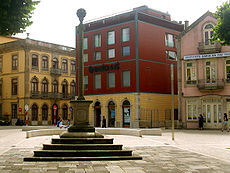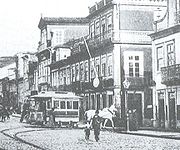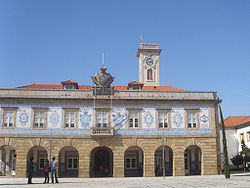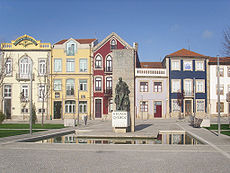
Praça do Almada
Encyclopedia
Praça do Almada is the civic center of the city of Póvoa de Varzim
in Portugal
, and is located in Póvoa de Varzim City Center
. It contains the sculpture that pays homage to Eça de Queiroz, a notable writer who was born there.
Praça do Almada plaza is about 14000 square metres (150,694.7 sq ft) in area. It is considered by the city as free space and part historical area of Póvoa de Varzim district. In 1791, by the royal provision of Queen Mary I
, the old Campo da Calçada became the civic center, initially named Praça Nova, or the New Square in English. It was also the place where the first public garden of Póvoa de Varzim was raised, and popular amongst the 19th century bourgeoisie. A legend speaks of a white owl that flies on the square between eleven thirty p.m. and midnight, which is associated with the incarnation of the soul of a person that deeply loved this square and did not want to ever leave it.
 The Calçada or Pavement was one of the exits of the urban core of Póvoa de Varzim in the 16th century, at the time the town was centered around Praça Velha
The Calçada or Pavement was one of the exits of the urban core of Póvoa de Varzim in the 16th century, at the time the town was centered around Praça Velha
, the Old Square. The toponym was assigned to ways, in the North of Portugal, that were paved where it was necessary. To the west, the Calçada ended next to the Town's Pillory of the 1514 Royal Charter
by King Manuel I
, that Flávio Gonçalves points out the construction in the reign of King John III
, a period of local development. On the Pillory site the development of the Street of the Blacksmiths (Rua dos Ferreiros) was initiated in 1568.
. The development of Póvoa de Varzim as an important fishery community in the 18th century prompted the royal provision by Queen Mary I. Forwarded by the queen on February 21, 1791, ordering Corregedor Francisco de Almada e Mendonça (the Almada) to reorganize the urbanization of Póvoa de Varzim, namely the creation of a new square in the old market square and substituting the diminished Old Square as the civic center. It was an area already delimited just north of the Calçada.
The royal representative, lieutenant colonel Frenchman
Reinaldo Oudinot, to the corregedor, ordered that "That in the Field of the Calçada there should be built a wide square for the markets and other streets and in this Square porch houses should be built , trees, and a fountain in the middle, everything in conformity with Colonel Lieutenant's plant".
 Work started in the year 1793 and, shortly after, became the new economic center of Póvoa de Varzim where the markets and fairs had been transferred. As such, in 1800 it was determined: "No-one can buy or sell firewood nor any other sorts of goods except on the Praça Nova of this town where all goods must be put on sale in order to be bought by who wants it."
Work started in the year 1793 and, shortly after, became the new economic center of Póvoa de Varzim where the markets and fairs had been transferred. As such, in 1800 it was determined: "No-one can buy or sell firewood nor any other sorts of goods except on the Praça Nova of this town where all goods must be put on sale in order to be bought by who wants it."
The square also linked the former civic center, the now Neighbourg of Matriz
, to the streets of the bustling fishing neighborhood of Junqueira. In the 18th century the main street was mostly settled by fishermen and the main fishing street of the town. Then the New square later came to be known as the Praça Nova do Almada or Almada's New Square, in honor to the corregedor, for having been one of the main boosters of the Royal Provision by Queen Mary I.
The meeting and leisure usefulness of the square was favored by the raising of the arches of the new town hall building, as it protected people from the weather. The new city hall, which was occupied in 1807, turned the new square into the political hub of the town.
The first efforts to build a gazebo occurred in 1896. It was an ephemeral structure, given that the current Art Nouveau
iron-casted gazebo was constructed at the site in 1904. This gazebo was inaugurated in 1905 with a play by the Povoense Band. The stage became not only a hub for plays and concerts, but also for meetings and debates.
Eça de Queiroz was born in Praça do Almada in 1845, in the old number 1 of Praça do Almada, house that opens up on São Sebastião square, currently named Eça de Queiroz Square due to this event. Carolina, his mother, dated Teixeira de Queiroz to whom became pregnant, to hide the pregnancy, Carolina moves to the house of her sister, Augusta Pereira d' Eça where the child was born. In 1906, to celebrate the birth of one of the greatest writers in the Portuguese language, a crowds gathers around the house, and a bronze plate, by Master Teixeira Lopes, is placed. The plate was offered by the Portuguese of Brazil
. The original house was controversially rebuilt in early 20th century, but the plate saved and placed on the newly built house.
 The square is landscaped in an egg-shape, cut in half by the National Highway 13, and is tipped by buildings with long-established national style. The building of the City Hall (1791), located in the north section, dominates the square and is of neoclassical design in the taste of the English settlement in Porto. This English influence is visible in the arches of ashlar masonry on the ground floor, with tiling, to the Portuguese taste, added in 1908-10 by Rocha Peixoto, of the authorship of the Belgian painter Joseph Bialman. In front of the city hall, the square’s ground has drawings with the blazon of the city and some siglas poveiras
The square is landscaped in an egg-shape, cut in half by the National Highway 13, and is tipped by buildings with long-established national style. The building of the City Hall (1791), located in the north section, dominates the square and is of neoclassical design in the taste of the English settlement in Porto. This English influence is visible in the arches of ashlar masonry on the ground floor, with tiling, to the Portuguese taste, added in 1908-10 by Rocha Peixoto, of the authorship of the Belgian painter Joseph Bialman. In front of the city hall, the square’s ground has drawings with the blazon of the city and some siglas poveiras
, considered of cultural interest and kept after the latest square rearrangement in 2007.
 To the west of the square is the Manueline pillory of Póvoa de Varzim, erected in 1514. It is a national monument and represents the municipal emancipation of Póvoa de Varzim. In front and in another part of the square, there's the Statue of Eça de Queirós, erected in 1952. It is of the authorship of Master Leopoldo de Almeida. The monument was offered by Povoan settlers in Rio de Janeiro
To the west of the square is the Manueline pillory of Póvoa de Varzim, erected in 1514. It is a national monument and represents the municipal emancipation of Póvoa de Varzim. In front and in another part of the square, there's the Statue of Eça de Queirós, erected in 1952. It is of the authorship of Master Leopoldo de Almeida. The monument was offered by Povoan settlers in Rio de Janeiro
. Next to the pillory, the square’s historical and romantic gazebo follows the liking of the old Povoan bourgeoisie for its spare time. With hexagonal plant, the gazebo is an illustration of cast iron architecture, with a very noticeable oriental influence, despite being stylized and geometric.
Praça do Almada is a hub for different city districts. Through the streets of Sousa Campos and the Junqueira shopping streets, one can reach the waterfront. Through the streets of Paulo Barreto and Gomes de Amorim, the northern and densely urbanized area of the city is reached. Eça de Queiroz Square, Praça do Almada has direct access to Bairro da Matriz, the most traditional quarter, and through to Ferreiros Street, a road from the 16th century that until the 19th century was used to get to Vila do Conde and Porto
, links the main square to the notorious fishing neighborhood known as Bairro Sul
.
Póvoa de Varzim
Póvoa de Varzim is a Portuguese city in the Norte Region and sub-region of Greater Porto, with a 2011 estimated population of 63,364. According to the 2001 census, there were 63,470 inhabitants with 42,396 living in the city proper. The urban area expanded, southwards, to Vila do Conde, and there...
in Portugal
Portugal
Portugal , officially the Portuguese Republic is a country situated in southwestern Europe on the Iberian Peninsula. Portugal is the westernmost country of Europe, and is bordered by the Atlantic Ocean to the West and South and by Spain to the North and East. The Atlantic archipelagos of the...
, and is located in Póvoa de Varzim City Center
Póvoa de Varzim City Center
Póvoa de Varzim City Center or Downtown Póvoa de Varzim is the heart of Póvoa de Varzim in Portugal, and is the location for most of the city's municipal services, tourist attractions and businesses. It is the center, not only for the city or the municipality, but also neighboring municipalities...
. It contains the sculpture that pays homage to Eça de Queiroz, a notable writer who was born there.
Praça do Almada plaza is about 14000 square metres (150,694.7 sq ft) in area. It is considered by the city as free space and part historical area of Póvoa de Varzim district. In 1791, by the royal provision of Queen Mary I
Maria I of Portugal
Maria I was Queen regnant of Portugal and the Algarves from 1777 until her death. Known as Maria the Pious , or Maria the Mad , she was the first undisputed Queen regnant of Portugal...
, the old Campo da Calçada became the civic center, initially named Praça Nova, or the New Square in English. It was also the place where the first public garden of Póvoa de Varzim was raised, and popular amongst the 19th century bourgeoisie. A legend speaks of a white owl that flies on the square between eleven thirty p.m. and midnight, which is associated with the incarnation of the soul of a person that deeply loved this square and did not want to ever leave it.
16th century: The Calçada

Praça Velha
thumb|The new First Church of Póvoa de Varzim, in Baroque style, started being built in 1743.Praça Velha , formerly known as Praça , was the primitive civic center and the market square of the city of Póvoa de Varzim in Portugal...
, the Old Square. The toponym was assigned to ways, in the North of Portugal, that were paved where it was necessary. To the west, the Calçada ended next to the Town's Pillory of the 1514 Royal Charter
Royal Charter
A royal charter is a formal document issued by a monarch as letters patent, granting a right or power to an individual or a body corporate. They were, and are still, used to establish significant organizations such as cities or universities. Charters should be distinguished from warrants and...
by King Manuel I
Manuel I of Portugal
Manuel I , the Fortunate , 14th king of Portugal and the Algarves was the son of Infante Ferdinand, Duke of Viseu, , by his wife, Infanta Beatrice of Portugal...
, that Flávio Gonçalves points out the construction in the reign of King John III
John III of Portugal
John III , nicknamed o Piedoso , was the fifteenth King of Portugal and the Algarves. He was the son of King Manuel I and Maria of Aragon, the third daughter of King Ferdinand II of Aragon and Queen Isabella I of Castile...
, a period of local development. On the Pillory site the development of the Street of the Blacksmiths (Rua dos Ferreiros) was initiated in 1568.
18th century: Praça Nova as the new civic center
In time, the field of the Calçada became the town's Market squareMarket square
The market square is a feature of many European and colonial towns. It is an open area where market stalls are traditionally set out for trading, commonly on one particular day of the week known as market day....
. The development of Póvoa de Varzim as an important fishery community in the 18th century prompted the royal provision by Queen Mary I. Forwarded by the queen on February 21, 1791, ordering Corregedor Francisco de Almada e Mendonça (the Almada) to reorganize the urbanization of Póvoa de Varzim, namely the creation of a new square in the old market square and substituting the diminished Old Square as the civic center. It was an area already delimited just north of the Calçada.
The royal representative, lieutenant colonel Frenchman
France
The French Republic , The French Republic , The French Republic , (commonly known as France , is a unitary semi-presidential republic in Western Europe with several overseas territories and islands located on other continents and in the Indian, Pacific, and Atlantic oceans. Metropolitan France...
Reinaldo Oudinot, to the corregedor, ordered that "That in the Field of the Calçada there should be built a wide square for the markets and other streets and in this Square porch houses should be built , trees, and a fountain in the middle, everything in conformity with Colonel Lieutenant's plant".

The square also linked the former civic center, the now Neighbourg of Matriz
Bairro da Matriz
Bairro da Matriz is the historical neighourhood of the Portuguese city of Póvoa de Varzim and part of the Matriz/Mariadeira district....
, to the streets of the bustling fishing neighborhood of Junqueira. In the 18th century the main street was mostly settled by fishermen and the main fishing street of the town. Then the New square later came to be known as the Praça Nova do Almada or Almada's New Square, in honor to the corregedor, for having been one of the main boosters of the Royal Provision by Queen Mary I.
The meeting and leisure usefulness of the square was favored by the raising of the arches of the new town hall building, as it protected people from the weather. The new city hall, which was occupied in 1807, turned the new square into the political hub of the town.
19th century: The public garden
Praça do Almada also had the intention of being a public garden, trendy in the 19th century, to be used by the high bourgeoisie. A proper market square was constructed in May 1873, with an elegant fountain in cast iron. However, it was considered that the daily market removed dignity to the civic center and a new market square was inaugurated in Praça do Marquês de Pombal square in 1904, and the fountain transferred to Dores Square, today in the garden of the Senhor do Monte street.The first efforts to build a gazebo occurred in 1896. It was an ephemeral structure, given that the current Art Nouveau
Art Nouveau
Art Nouveau is an international philosophy and style of art, architecture and applied art—especially the decorative arts—that were most popular during 1890–1910. The name "Art Nouveau" is French for "new art"...
iron-casted gazebo was constructed at the site in 1904. This gazebo was inaugurated in 1905 with a play by the Povoense Band. The stage became not only a hub for plays and concerts, but also for meetings and debates.
Eça de Queiroz was born in Praça do Almada in 1845, in the old number 1 of Praça do Almada, house that opens up on São Sebastião square, currently named Eça de Queiroz Square due to this event. Carolina, his mother, dated Teixeira de Queiroz to whom became pregnant, to hide the pregnancy, Carolina moves to the house of her sister, Augusta Pereira d' Eça where the child was born. In 1906, to celebrate the birth of one of the greatest writers in the Portuguese language, a crowds gathers around the house, and a bronze plate, by Master Teixeira Lopes, is placed. The plate was offered by the Portuguese of Brazil
Portuguese-Brazilian
Portuguese Brazilians are Brazilian citizens whose ancestry originates wholly or partly in Portugal. Most of the Portuguese arrived throughout the centuries to Brazil, sought economic opportunities...
. The original house was controversially rebuilt in early 20th century, but the plate saved and placed on the newly built house.
Urban morphology

Siglas poveiras
The siglas poveiras is a proto-writing system that has been used by the local community of Póvoa de Varzim in Portugal for many generations. The siglas were primarily used as a signature for family coat-of-arms in order to mark family belongings...
, considered of cultural interest and kept after the latest square rearrangement in 2007.

Rio de Janeiro
Rio de Janeiro , commonly referred to simply as Rio, is the capital city of the State of Rio de Janeiro, the second largest city of Brazil, and the third largest metropolitan area and agglomeration in South America, boasting approximately 6.3 million people within the city proper, making it the 6th...
. Next to the pillory, the square’s historical and romantic gazebo follows the liking of the old Povoan bourgeoisie for its spare time. With hexagonal plant, the gazebo is an illustration of cast iron architecture, with a very noticeable oriental influence, despite being stylized and geometric.
Praça do Almada is a hub for different city districts. Through the streets of Sousa Campos and the Junqueira shopping streets, one can reach the waterfront. Through the streets of Paulo Barreto and Gomes de Amorim, the northern and densely urbanized area of the city is reached. Eça de Queiroz Square, Praça do Almada has direct access to Bairro da Matriz, the most traditional quarter, and through to Ferreiros Street, a road from the 16th century that until the 19th century was used to get to Vila do Conde and Porto
Porto
Porto , also known as Oporto in English, is the second largest city in Portugal and one of the major urban areas in the Iberian Peninsula. Its administrative limits include a population of 237,559 inhabitants distributed within 15 civil parishes...
, links the main square to the notorious fishing neighborhood known as Bairro Sul
Bairro Sul
Bairro Sul, literally the South Neighborhood, also known as Lapa, is the fishery district of the city of Póvoa de Varzim in Portugal. It is one of the six traditional neirghborhoods of Póvoa de Varzim and one of the eleven parts in which the city is subdivided. The quarter is situated south of...
.
Listed heritage
According to Plano de Urbanização da Póvoa de Varzim:- Praça do Almada (free space with patrimonial importance).
- Pelourinho - Pillory of Póvoa de Varzim
- Gazeto of Praça do Almada
- Póvoa de Varzim City Hall
- Old Hotel Universal
- Eça de Queiroz House
- São Sebastião Fountain
- Cruzeiro verde - Calvary

